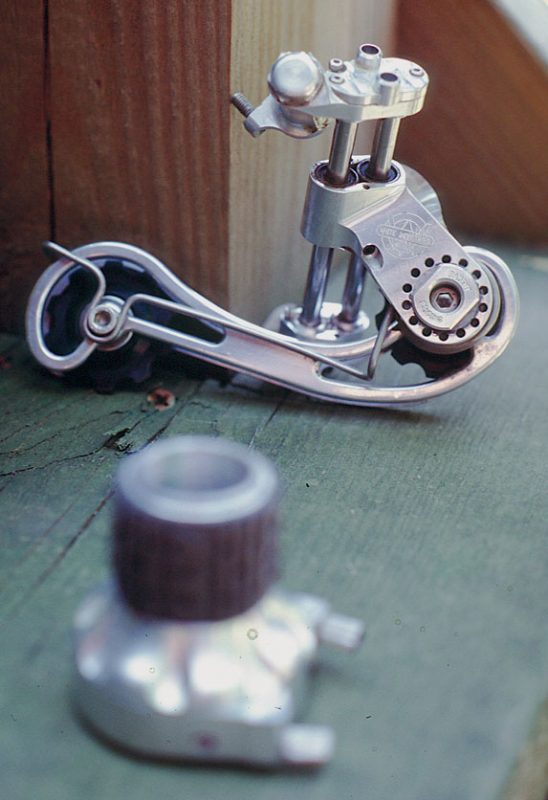Blast From the Past: White Industries Linear Motion Derailleur System
Originally posted on October 13, 2016 at 7:27 am
Editor’s note: This product review appeared in Dirt Rag Issue #66, published in July 1998. Words by Chris Cosby. Photo by Maurice Tierney.
Imagine this scenario. You pull into the trailhead parking lot in your Land Rover, unload your BowTi, start to strap on your Kevlar Sidi’s when Chad pulls up. Always the one-upmanship master, he parks his Humvee in the adjacent space, unracks his beryllium wunderbike and starts to suit up. None of this really fazes you until you notice his White Industries Linear Motion Derailleur System (LMDS). Now you’re steamed. You were assured by Pierced Pete at the local shop that your Rapid Rise XTR derailleur was the last word in bicycle technology. Now you’re staring at the finely machined alloy pieces that make up the White LMDS and you wonder how you ever fell so far out of touch.
While this scene might not be real to you, it is true that some of us are interested in the latest technology. The White Industries LMDS was created to offer an alternative to traditional spring tension actuated derailleurs and shifters. The design utilizes a continuous loop cable for both shifters that provides an even tension for upshifts and downshifts. In addition, the rear derailleur travels on a linear “track,” instead of a pivoting parallelogram common in other derailleurs.
Included in an LMDS system are two machined alloy twist style shifters, the rear derailleur, a pulley to convert your existing front derailleur (more on this later), stainless steel braided cables, Teflon housing, and alloy “double” cable stops to accomodate the cables returning to the shifters.
Installation is a process not unlike rebuilding a swiss watch, with tiny 1.5 mm allen head bolts that are easy to lose. An experienced mechanic should allow a couple of hours; inexperienced folks should let the shop wrench have a go at it. There are two options for cable setup: One option is to utilize the double stops provided, with housing between the stops only; the second option is to use full housing between shifter and changer. The later requires zip tying the housing to the frame, since there are no cable stops used.
I chose to use the double stops since I thought it would be a cleaner arrangement. The only problem I found was that the four exposed cables running along my top tube sounded like a symphony of bad banjos while riding down a trail. If you like a quiet ride (I sure do!), then opt for the full cable setup.
The cables are routed from the shifter all the way to the changer and back, where they are secured by a set screw inside the shifter housing. It’s important to use the shrink wrap on the cable end or else it will fray and bind inside the shifter. The return spring in the front derailleur is removed, and the pulley is used in its place, thus making your front changer springless like the back.

Once installed and on the trail, the first thing I noticed about the LMDS was the short throw of the shifters. It was very easy to overshift at first, but I soon got used to it and found that I could hit the gear I needed quicker than before. The front shifter has built in stops that prevent double shifts, and that took some getting used to as well. In order to shift through the entire range up front, it’s necessary to push inward to get past the stops. The first front shifter I had seized up early on, preventing any travel in either direction. Once this shifter was replaced, however, the problem went away. (There is a one year warranty on defects.)
The overall design of the LMDS has some advantages over traditional systems in that there is consistent tension when shifting up or down. This would prove to be a greater advantage if you ride in muddy or wet conditions, where spring loaded derailleurs can cause increased tension at the shifters. I also liked the range of adjustability built into the rear derailleur. The angle of the cage and the distance from the top pulley to the cogs are both adjustable. The rear derailleur is completely rebuildable, too. It’s also very svelte in appearance, and it has the wow factor. Everything provided with the system is of top notch quality, right down to the solid Teflon housing. On the downside, I found the alloy to be quite soft. It would be very easy to strip or cross-thread the miniature bolts, and getting at the shifter bolts required moving the brake lever out of the way.
Compared to XTR Rapid Rise at 227 grams, the rear derailleur is light at 179 grams. But some of the weight savings are negated by the additional cable and housing. The complete system weighed 530 grams. The White Industries LMDS retails for $285, while the XTR rear changer and shifters would run around $250. If you want the latest in design and some of the finest machined parts available today, then drive your Land Rover on over to your local shop or contact White Industries.
Keep reading
We’ve published a lot of stuff in 27 years of Dirt Rag. Find all our Blast From the Past stories here.